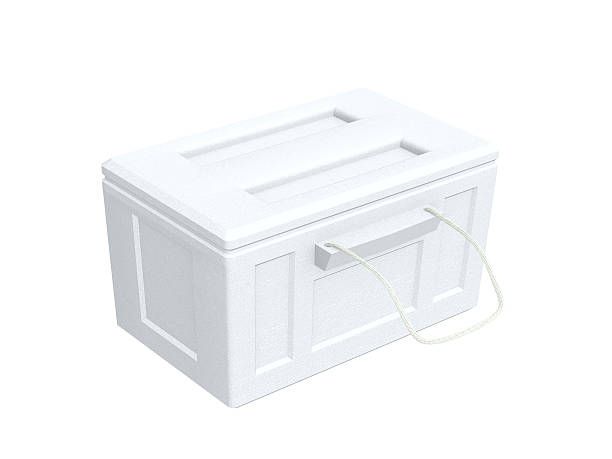Styrofoam Coolers For Packaging: Benefits, Environmental Impact & Alternatives
When it comes to shipping cold items over long distances, styrofoam coolers can seem like your best option. Styrofoam coolers are extremely lightweight and insular which makes them a great, cost-effective way of storing and shipping large quantities of cold items that need to be protected from heat over a long period of time.
What we know as styrofoam is actually a colloquial term for a foam made out of a synthetic hydrocarbon polymer called expanded polystyrene (EPS) or extruded polystyrene (XPS). Besides packaging, styrofoam is also extensively used to make disposable cutlery and in-home insulation. Architects use styrofoam in its concrete form extensively because of its air pockets that make it a great material to insulate homes against harsh weather conditions.
However, the material that makes these coolers and the manufacturing process can both be extremely harmful to the environment and human health. The production and biodegradation process releases harmful chemicals into the atmosphere. As a result of these negative impacts, styrofoam has been banned for commercial use in several US states and cities such as California, Washington, and Portland and Countries like Canada and Taiwan.

What Are The Benefits Of Using Styrofoam Coolers?
Styrofoam coolers can be the holy grail for packaging items that need to be protected from the heat. The insulating polystyrene foam prevents contained items from getting spoilt and effectively maintains their temperature.
When compared to other forms of plastic insulation, styrofoam coolers have higher resistance to moisture giving them the ability to provide better efficiency in insulating for a longer period of time.
Foam polystyrene tends to be more than 95 percent air which makes it extremely lightweight. If you're exporting cold items or running a food delivery business, this helps in keeping shipping costs low.
Because of their versatility and wide range of sizes, styrofoam coolers can also be used for personal use, for beach days, and when you are going camping and need to keep things cool.
Environmental and Other Issues With Polystyrene Foam
Unfortunately, polystyrene can take hundreds of years to fully biodegrade and is resistant to photo-oxidation. During the process of biodegradation, styrofoam also leaches toxic chemicals into the environment.
Styrofoam is so commonly used that of all the waste materials that ultimately end up in landfills, 30% are made of styrofoam. While the material has been FDA approved for food packaging, when exposed to sunlight, it creates air pollutants that can be extremely harmful to inhale and also deplete the ozone layer.
The manufacturing process itself is extremely harmful and causes the release of more than 50 chemical byproducts which contaminate the air and water for the communities that live around these manufacturing facilities. One of the most toxic chemicals released is called styrene which is considered carcinogenic. Styrene exposure can cause skin irritation and inflammation in our and prolonged exposure can have even more adverse health impacts such as disrupted kidney function and loss of hearing.
Sustainable & Eco-Friendly Alternatives To Styrofoam Coolers
It is hard to match styrofoam coolers when it comes to ease of use, the lightweight material, and extremely affordable price point. However, if you are willing to spend a couple of extra bucks to be kinder to the environment, Igloo Coolers have come up with a 100 percent biodegradable alternative to foam coolers called Recool.
The best part about recool is that it is both lightweight and can be reused over and over again. It simply needs to be air-dried before it's ready for the next journey. It can also hold up to 75 lbs!
Another company called Ecovative Design has come up with a proprietary mushroom packaging technology made from just two ingredients: hemp hurds and mycelium. These have the same insulation properties as Styrofoam at a fraction of the environmental impact. This alternative form of packaging is water-resistant and can compost in 45 days!
Landaal has developed a new kind of compostable foam called Green Cell Foam that is made from US-grown corn. Much like styrofoam, it has the capacity to insulate and protect the items it contains. While the material is not recyclable, it is fully compostable and makes for great natural plant food.
Other Frequently Asked Questions
Is Styrofoam Recyclable?
Styrofoam is not an easy material to recycle and does not follow the traditional recycling process. While styrofoam is generally up to 95 percent air, its other main raw material is styrene which is a petroleum-based product.
Styrofoam or polystyrene foam is a thermoplastic. When it comes to recycling, plastics are given a rating from 1 to 7 depending on their recyclability and disposal method. PET plastics (the kind we see in water bottles) are generally classified as either 1 or 2, which means that they are easily recycled. However, plastics that are classified under 4 to 7 are not considered universally recyclable. Polystyrene foam is classified as a number 6 plastic.
Because polystyrene is so lightweight, it needs to be ground and then compacted to take a more dense form. This new form is then recycled. However, most recycling facilities do not have the technology needed to pulverize and then compact the material and therefore are unable to recycle it. As a result of this, a very high percentage of polystyrene ends up in landfills.
Can You Microwave Styrofoam?
It depends. The FDA in the United States regulates food-safe plastic and polystyrene cups and containers. They also test these containers for microwave safety. Containers that pass these tests are labeled as microwave-safe.
When planning in microwaving styrofoam containers, always check for this microwave-safe label. When in doubt, avoid microwaving styrofoam. This is because styrofoam is made of a toxic chemical called styrene which might leak and contaminate your food. Styrene is carcinogenic and prolonged exposure to it can cause cancer.
This should not be a cause for concern for containers that have been labeled microwave-safe by the FDA, but in case you have concerns, just transfer the contents to a glass or pyrex container.
With the plenty of new and improved alternatives to styrofoam, consumers and business owners with a need to insulate can now make conscious choices that are better for the environment and have a minimal impact on the planet.
Countries around the world are waking up to the negative impacts of the production and consumption of polystyrene foam and many have banned it from commercial use. This should serve as a good driving point for the negative impacts of its use both for our planet and our own health. It should also encourage us all to seek other, better alternatives from the multitude of existing options.
